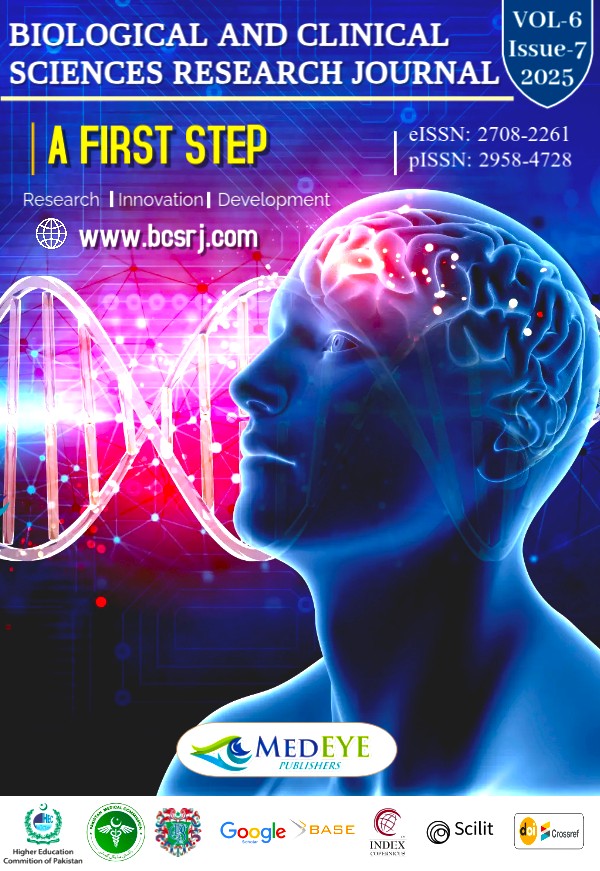Effect of Risk Factors on LV Systolic Dysfunction After Acute ST Elevation Myocardial Infarction
DOI:
https://doi.org/10.54112/bcsrj.v6i7.1868Keywords:
ST-elevation myocardial infarction, left ventricular dysfunction, risk factors, echocardiography, cardiovascular disease, PakistanAbstract
Left ventricular (LV) systolic dysfunction is a common complication following acute ST-elevation myocardial infarction (STEMI), particularly anterior wall infarctions. Several modifiable and non-modifiable cardiovascular risk factors, including diabetes, hypertension, smoking, obesity, and family history, have been implicated in the development of post-infarction LV dysfunction. However, the independent predictive value of these risk factors remains unclear in specific populations such as those in Pakistan. Objective: To assess the effect of major cardiovascular risk factors on the development of LV systolic dysfunction in patients presenting with a first episode of anterior STEMI. Methods: This observational cross-sectional study was conducted at the Department of Cardiology, Pervaiz Elahi Institute of Cardiology, Bahawalpur, Pakistan, over six months (July 2023 to January 2024). A total of 114 patients aged 25–70 years with first anterior STEMI were enrolled. Clinical and demographic data were recorded, and LV function was evaluated via echocardiography within 72 hours of admission. LV systolic dysfunction was defined as an ejection fraction <40%. Statistical associations between risk factors and LVD were assessed using chi-square tests. Results: The mean age of the cohort was 42.62 ± 10.13 years; 59.6% were male. Common risk factors included smoking (40.4%), diabetes (29.8%), hypertension (50%), and obesity (40.4%), while 59.6% had a positive family history of ischemic heart disease. LV systolic dysfunction was present in 20.2% of patients. No statistically significant association was found between LVD and age, gender, smoking, diabetes, hypertension, obesity, or family history (p > 0.05 for all). Conclusion: Although traditional cardiovascular risk factors were prevalent in patients presenting with anterior STEMI, none demonstrated a statistically significant association with early LV systolic dysfunction in this cohort. These findings suggest that additional pathophysiological or genetic factors may contribute to post-infarction LV impairment, underscoring the need for broader risk assessment and longitudinal studies in South Asian populations.
Downloads
References
Vitel A., Sporea I., Mare R., Banciu C., Bordejevic D., Parvanescu T.et al..
association between subclinical left ventricular myocardial systolic dysfunction detected by strain and strain rate imaging and liver steatosis and fibrosis detected by elastography and controlled attenuation parameter in patients with metabolic syndrome
. Diabetes Metabolic Syndrome and Obesity Targets and Therapy 2020;Volume 13:3749-3759. https://doi.org/10.2147/dmso.s268916Chen Y., Zhang Y., Wang Y., Ta S., Shi M., Zhou Y.et al.. Assessment of subclinical left ventricular systolic dysfunction in patients with type 2 diabetes: relationship with hba1c and microvascular complications. Journal of Diabetes 2023;15(3):264-274. https://doi.org/10.1111/1753-0407.13369
Ng A., Bertini M., Ewe S., Velde E., Leung D., Delgado V.et al.. Defining subclinical myocardial dysfunction and implications for patients with diabetes mellitus and preserved ejection fraction. The American Journal of Cardiology 2019;124(6):892-898. https://doi.org/10.1016/j.amjcard.2019.06.011
Yamauchi Y., Tanaka H., Yokota S., Mochizuki Y., Yoshigai Y., Shiraki H.et al.. Effect of heart rate on left ventricular longitudinal myocardial function in type 2 diabetes mellitus. Cardiovascular Diabetology 2021;20(1). https://doi.org/10.1186/s12933-021-01278-7
Nwabuo C., Moreira H., Vasconcellos H., Mewton N., Opdahl A., Ogunyankin K.et al.. Left ventricular global function index predicts incident heart failure and cardiovascular disease in young adults: the coronary artery risk development in young adults (cardia) study. European Heart Journal - Cardiovascular Imaging 2018;20(5):533-540. https://doi.org/10.1093/ehjci/jey123
Tadić M., Cuspidi C., & Marwick T.. Phenotyping the hypertensive heart. European Heart Journal 2022;43(38):3794-3810. https://doi.org/10.1093/eurheartj/ehac393
Omar T., Hamideyin Ş., Karakayalı M., Artaç İ., Karabağ Y., Dündar C.et al.. Evaluation of cardiac electromechanics in patients with newly diagnosed hypertension. Blood Pressure Monitoring 2023;28(6):303-308. https://doi.org/10.1097/mbp.0000000000000667
Choi S., Lee Y., Park H., Kim D., Cho A., Kang M.et al.. Clinical significance of central systolic blood pressure in lv diastolic dysfunction and cv mortality. Plos One 2021;16(5):e0250653. https://doi.org/10.1371/journal.pone.0250653
Minciună I., Orăşan O., Minciună I., Lazar A., Sitar-Tăut A., Oltean M.et al.. Assessment of subclinical diabetic cardiomyopathy by speckle‐tracking imaging. European Journal of Clinical Investigation 2021;51(4). https://doi.org/10.1111/eci.13475
Bm A., Raman R., Prabha R., Kaushal D., Kaushik K., Rahul K.et al.. Left ventricular systolic function changes during pump-assisted beating heart coronary artery bypass graft surgery: a prospective observational study. Cureus 2024. https://doi.org/10.7759/cureus.73011
Szekely Y., Lichter Y., Taieb P., Banai A., Hochstadt A., Merdler I.et al.. Spectrum of cardiac manifestations in covid-19. Circulation 2020;142(4):342-353. https://doi.org/10.1161/circulationaha.120.047971
Овчинников А., Belyavskiy E., Потехина А., & Агеев Ф.. Asymptomatic left ventricular hypertrophy is a potent risk factor for the development of hfpef but not hfref: results of a retrospective cohort study. Journal of Clinical Medicine 2022;11(13):3885. https://doi.org/10.3390/jcm11133885
Moran A., Forouzanfar M., Roth G., Mensah G., Ezzati M., Murray C.et al.. Temporal trends in ischemic heart disease mortality in 21 world regions, 1980 to 2010. Circulation 2014;129(14):1483-1492. https://doi.org/10.1161/circulationaha.113.004042
Thiele H., Zeymer U., Neumann F., Ferenc M., Olbrich H., Hausleiter J.et al.. Intraaortic balloon support for myocardial infarction with cardiogenic shock. New England Journal of Medicine 2012;367(14):1287-1296. https://doi.org/10.1056/nejmoa1208410
Timmers L., Sluijter J., Keulen J., Hoefer I., Nederhoff M., Goumans M.et al.. Toll-like receptor 4 mediates maladaptive left ventricular remodeling and impairs cardiac function after myocardial infarction. Circulation Research 2008;102(2):257-264. https://doi.org/10.1161/circresaha.107.158220
Khaled S. and Shalaby G.. Severe left ventricular dysfunction earlier after acute myocardial infarction treated with primary percutaneous coronary intervention: predictors and in-hospital outcome– a middle eastern tertiary center experience. Journal of the Saudi Heart Association 2023;34(4):257-263. https://doi.org/10.37616/2212-5043.1325
Eitel I., Desch S., Waha S., Fuernau G., Gutberlet M., Schüler G.et al.. Long-term prognostic value of myocardial salvage assessed by cardiovascular magnetic resonance in acute reperfused myocardial infarction. Heart 2011;97(24):2038-2045. https://doi.org/10.1136/heartjnl-2011-300098
Masci P., Ganame J., Francone M., Desmet W., Lorenzoni V., Iacucci I.et al.. Relationship between location and size of myocardial infarction and their reciprocal influences on post-infarction left ventricular remodelling. European Heart Journal 2011;32(13):1640-1648. https://doi.org/10.1093/eurheartj/ehr064
Xie J., Cui K., Hao H., Zhang Y., Lin H., Chen Z.et al.. Acute hyperglycemia suppresses left ventricular diastolic function and inhibits autophagic flux in mice under prohypertrophic stimulation. Cardiovascular Diabetology 2016;15(1). https://doi.org/10.1186/s12933-016-0452-z
Kwon T., Bae J., Jeong M., Kim Y., Hur S., Seong I.et al.. N-terminal pro-b-type natriuretic peptide is associated with adverse short-term clinical outcomes in patients with acute st-elevation myocardial infarction underwent primary percutaneous coronary intervention. International Journal of Cardiology 2009;133(2):173-178. https://doi.org/10.1016/j.ijcard.2007.12.022
Toufektsian M., Robbez-Masson V., Sanou D., Jouan M., Ormezzano O., Leiris J.et al.. A single intravenous stnfr-fc administration at the time of reperfusion limits infarct size—implications in reperfusion strategies in man. Cardiovascular Drugs and Therapy 2008;22(6):437-442. https://doi.org/10.1007/s10557-008-6130-y
Lagan J., Connor V., & Saravanan P.. Takotsubo cardiomyopathy case series: typical, atypical and recurrence. BMJ Case Reports 2015;2015:bcr2014208741. https://doi.org/10.1136/bcr-2014-208741
Kim D., Park C., Jin E., Hwang H., Sohn I., Cho J.et al.. Predictors of decreased left ventricular function subsequent to follow-up echocardiography after percutaneous coronary intervention following acute st-elevation myocardial infarction. Experimental and Therapeutic Medicine 2018. https://doi.org/10.3892/etm.2018.5962
Komanapalli C., Sister M., Blizzard J., Malloy T., Stuesse D., & Ravichandran P.. Simultaneous repair of acute ischemic vsd with lv remodeling. Journal of Cardiac Surgery 2006;21(1):66-68. https://doi.org/10.1111/j.1540-8191.2006.00185.x
Downloads
Published
How to Cite
Issue
Section
License
Copyright (c) 2025 Muhammad Sarwar Khalid, Fouzia Goher, Asif Ali, Aaqib Javaid, Zoobia Sarwar

This work is licensed under a Creative Commons Attribution-NonCommercial 4.0 International License.








